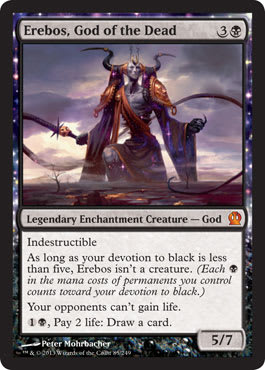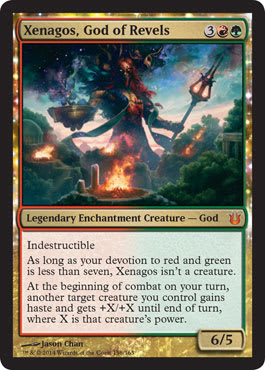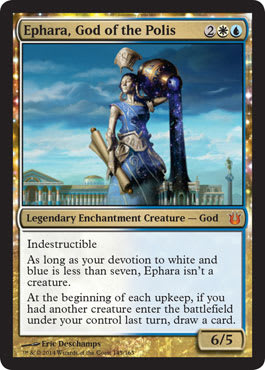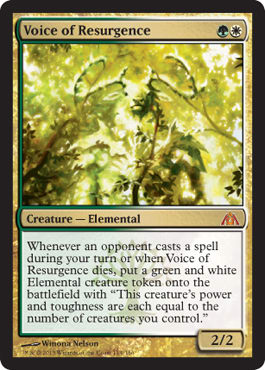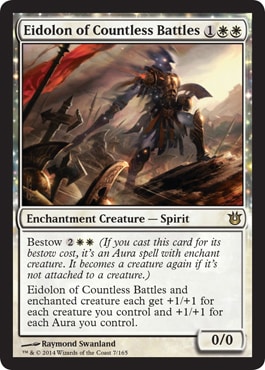While I was concerned when I first saw Bile Blight spoiled, I wasn’t up in arms that Mono-Black Control received another new tool since I figured Born of the Gods would bring tools to other decks, and we didn’t quite see that. What we ended up with was a Dragon’s Maze–level release in which there’s a handful of obviously strong cards, a handful of interesting ones, and some sideboard help. What will make or break this set, much like Dark Ascension and Dragon’s Maze, will be how cards in that middle group fare in the long run.
For now, though, let’s focus on the level-one problems that pop up now that BNG is about to be released.
Mono-Black Control Only Grew Stronger
Not only does Bile Blight take away the need to pick a second-tier removal spell, all of which had different weaknesses, it slots into the same mana slot as well. The kicker is that the best tool against Pack Rat is now available in the same color as the Rat itself. Unfortunately, this was not only what MBC gained, it also picked up Drown in Sorrow, a strict upgrade on Infest. What Drown does is take away the aggressive route of beating MBC. You can still play aggressive cards against it, but playing conservatively against Pack Rat and Desecration Demon is a tough tightrope to cross. It only becomes tougher when the deck has Hero's Downfall, Doom Blade, and Bile Blight as removal options, cards that largely don’t care about the text on your card.
"Mono-Black Control"
- Creatures (18)
- 4 Desecration Demon
- 4 Gray Merchant of Asphodel
- 4 Nightveil Specter
- 4 Pack Rat
- 2 Erebos, God of the Dead
- Spells (16)
- 4 Bile Blight
- 4 Hero's Downfall
- 4 Thoughtseize
- 4 Underworld Connections
- Lands (26)
- 16 Swamp
- 2 Temple of Malice
- 4 Mutavault
- 4 Temple of Deceit
- Sideboard (15)
- 3 Duress
- 1 Erebos, God of the Dead
- 3 Pharika's Cure
- 3 Dark Betrayal
- 2 Drown in Sorrow
- 3 Lifebane Zombie
So now we have all-in aggro decks being brick-walled in the metagame, and you mostly are punished for playing conservatively. Now what? Well, the next place to look would be at control and building a better mouse trap for the control mirror. We run into the same primary issue there though: Thoughtseize cards not for whatever idea you had for winning a good, clean game of Magic. You can’t have reasonable counterplay against it, and your stumbles become all the more crippling when playing against Thoughtseize. This wouldn’t be so bad, except Erebos, God of the Dead and Underworld Connections are efficient enough that they can keep up with the blue card-draw options of Jace, Architect of Thought and Sphinx's Revelation in the long game.
So for week one at least, the correct answer to, “What do I play?” is Mono-Black Control. It has the best threats and answers in the format with rock solid mana consistency. Of course, Magic players hate stagnant formats, and I’m no exception. What does beat MBC?
Right now, W/U Control can do a reasonable job of containing the biggest threats in the black deck and can keep up in terms of card-draw. Sometimes, it’ll become overwhelmed early or drown because it couldn’t keep a Jace or stick a Sphinx, but the rest of the time, W/U will at least go to a long game and have a shot at winning. If you enjoy long games and were sad that you only had a set of Detention Sphere to hit MBC’s permanents with, Revoke Existence will help ease your pain. Having multiple ways to take out Underworld Connections and Erebos should help keep the matchup from becoming any worse.
If you dislike W/U Control and want to have a shot against MBC, I’d look to go big with R/G Devotion. Normally, I’d look at you like you were crazy: Why take a seat against a deck full of spot removal and Lifebane Zombie? Well, most lists are probably only going to have the set of Hero's Downfall as removal that can take out your biggest creatures, and Lifebane Zombie is now only a sideboard option. Meanwhile, large, green creatures are some of your best options for plowing through Nightveil Specter and Pack Rat on defense while also pressuring the opponent’s life total so he or she can’t just dig for answers.
Xenagos, God of Revels can do an impressive Fires of Yavimaya impression when necessary, and you have enough of a threat density to not be taken apart by pinpoint discard. If MBC becomes a heavier part of the metagame, niche options like Witchstalker also becomes attractive, fitting nicely with Xenagos and Boon Satyr. Cards that had fallen out of favor, such as Kalonian Hydra, might be worth a tryout again with fewer Doom Blades and more Bile Blights in the format.
W/U Devotion decks became a lot more interesting over their mono-colored counterparts thanks to Ephara, God of the Polis. Not only does she provide a draw engine that doesn’t cost ![]()
![]() , but the color combo also provides a cache of excellent creatures and devotion enablers. This set makes Nykthos, Shrine to Nyx way more interesting for dual-colored plans while powering up Elspeth, Sun's Champion, Angel of Serenity, and Sphinx's Revelation.
, but the color combo also provides a cache of excellent creatures and devotion enablers. This set makes Nykthos, Shrine to Nyx way more interesting for dual-colored plans while powering up Elspeth, Sun's Champion, Angel of Serenity, and Sphinx's Revelation.
Here’s my early draft to give you an idea of what I’m talking about:
"W/U Control"
- Creatures (24)
- 1 Angel of Serenity
- 2 Imposing Sovereign
- 3 Banisher Priest
- 3 Lyev Skyknight
- 4 Precinct Captain
- 4 Soldier of the Pantheon
- 1 Heliod, God of the Sun
- 3 Brimaz, King of Oreskos
- 3 Ephara, God of the Polis
- Planeswalkers (3)
- 1 Ajani, Caller of the Pride
- 2 Elspeth, Sun's Champion
- Spells (8)
- 2 Brave the Elements
- 4 Detention Sphere
- 2 Spear of Heliod
- Lands (25)
- 10 Plains
- 4 Azorius Guildgate
- 4 Hallowed Fountain
- 4 Temple of Enlightenment
- 3 Nykthos, Shrine to Nyx
This shell excites me greatly for battling back against MBC and W/U Control, which are the top decks coming into the new format. With a lack of removal Game 1, it isn’t going to have a fun time against R/G Devotion decks, and, in fact, it may need to sideboard Supreme Verdict purely for those matchups. Against slower, attrition-based strategies, though, this deck does a great job of fighting them directly. For early threats, such opponents can’t ignore Precinct Captain or Brimaz, King of Oreskos for long when backed by Spear of Heliod, and once we hit our mana stride, both Gods, Angel of Serenity, and Elspeth, Sun's Champion provide a lot of support.
Right now, Ephara, God of the Polis is my favorite card in the set, and she’s the one I think has the highest chance to spawn a new archetype. She provides repeatable draw and plays well with many of the established cards in white decks. Many of the gold cards already seeing heavy play in W/U Control can also be slotted in here with varying degrees of success. I’m sure someone right now is making a version of this deck with three to four Angel of Serenity and Sphinx's Revelation so he or she can just go over the top of everyone without Nykthos.
Red also may have been buried a bit prematurely depending on how the metagame shakes out. If Mono-Blue Devotion stays a contender, we could have some issues keeping this deck in the competitive stables, but if it falls in popularity, it provides a prime opportunity for a red comeback. Boros and Rakdos both have produced reasonable aggro shells during Standard, and while they haven’t gained a large quantity of cards, they came through with Searing Blood and at least a handful of cards worth trying out.
This was my immediate first draft for a red deck:
"Red Aggro"
- Creatures (18)
- 3 Firedrinker Satyr
- 3 Young Pyromancer
- 4 Burning-Tree Emissary
- 4 Chandra's Phoenix
- 4 Rakdos Cackler
- Planeswalkers (2)
- 2 Chandra, Pyromaster
- Spells (17)
- 2 Dynacharge
- 3 Shock
- 4 Lightning Strike
- 4 Magma Jet
- 4 Searing Blood
No frills, just a lot of aggression and the potential Dynacharge blowout against Last Breath or a turn-four kill. My immediate problem wasn’t against W/U Control as I originally anticipated, though you still need Mizzium Mortars post-board specifically to deal with Archangel of Thune. My issue was that the updated MBC list was just much better at dealing with early red hordes, and the amount of damage I believed I could rely on was inaccurate. Instead, against early draws that could potentially consist of Pharika's Cure, Bile Blight, and Drown in Sorrow post-board, I was no longer having a fun time. Bile Blight in particular surprised me since I figured it was just Doom Blade, except now it ruined any hand involving overlapping 1-drops or two copies of Burning-Tree Emissary.
With this in mind, I tweaked the deck toward the Boros Burn decks that were popular around six weeks ago and retried the MBC and W/U Control matches.
"Boros Burn"
- Creatures (11)
- 3 Stormbreath Dragon
- 4 Chandra's Phoenix
- 4 Young Pyromancer
- Planeswalkers (2)
- 2 Chandra, Pyromaster
- Spells (23)
- 3 Shock
- 4 Boros Charm
- 4 Lightning Strike
- 4 Searing Blood
- 4 Warleader's Helix
- 4 Chained to the Rocks
- Lands (24)
- 10 Mountain
- 2 Boros Guildgate
- 4 Mutavault
- 4 Sacred Foundry
- 4 Temple of Triumph
- Sideboard (15)
- 2 Hammer of Purphoros
- 1 Chandra, Pyromaster
- 1 Stormbreath Dragon
- 3 Mizzium Mortars
- 4 Satyr Firedancer
- 4 Boros Reckoner
This was much more encouraging in the results department—I was no longer hamstrung by losing value early on 1-drops. Previously, one of the best reasons to have the 1-drops in the deck was to pressure W/U and MBC and force early interaction out of them. Now, at least for MBC, that advantage is lost, and going bigger and sticking with more burn and noncreature threats felt like the correct move. Notably, Satyr Firedancer is a huge gain against devotion decks of the nonblack variety and can absolutely dominate a game. It turns Boros Charm into Mizzium Mortars, dealing 4 to your opponent and to a creature he or she controls. It makes all your cheap removal do double-duty and pressure the opponent.
I don’t main-deck it because of how it plays out against decks with heavy removal or no creatures, making it mediocre against W/U Control and MBC. Against everyone else, though, the Firedancer requires a removal spell or you’ll just roll over the opponent through incremental value. Hammer of Purphoros and Chandra, Pyromaster still play their typical roles against control plans. What I was finding was that your matchups against devotion became far better and your W/U Control and MBC matches mostly stayed even, with the W/U Control match being unfavorable post-board and MBC being slightly favorable if you had Skullcrack and Toil // Trouble.
Before jumping to other archetypes, though, I did mention a Rakdos deck, and I do think it has real potential.
"Rakdos Aggro"
- Creatures (12)
- 4 Oracle of Bones
- 4 Pain Seer
- 4 Satyr Firedancer
- Spells (22)
- 4 Lightning Strike
- 4 Magma Jet
- 4 Searing Blood
- 4 Shock
- 4 Toil // Trouble
- 2 Rakdos's Return
- Lands (24)
- 6 Mountain
- 2 Rakdos Guildgate
- 4 Blood Crypt
- 4 Mutavault
- 4 Temple of Malice
- 4 Temple of Triumph
- Sideboard (15)
- 4 Pack Rat
- 4 Thoughtseize
- 3 Dark Betrayal
- 2 Erebos, God of the Dead
- 2 Stormbreath Dragon
My friend James (Zemanjaski) also had an interesting take on the Rakdos deck more focused on value, and he used Xathrid Necromancer and Young Pyromancer (think anything with –mancer on the end), and it looked pretty interesting. He’ll be writing about that one soon, though, so I won’t spoil it here. Basically, think of how the B/R midrange decks played for a week toward the beginning of the season, and then skew it toward an early game. There’s some nice synergy with Pain Seer, Pyromancer, and Necromancer backed by burn spells.
One of the less-talked-about things that could be a big game is Naya, which not only gained Temple of Plenty to help the mana issues, but also a host of good R/G options to go in the deck. The core of mana creatures, Voice of Resurgence, and awesome G/W cards alongside Xenagos, God of Revels and Fanatic of Xenagos could be a perfect fit. One of the best ways to beat MBC is to simply overload the opponent with must-kill threats, and the deck may be on the tipping point for that strategy to pay off.
What makes this hard to pull off, though, is the existence of Lifebane Zombie coming out of MBC sideboards. Game 1 isn’t that bad, as only Thoughtseize can really rip some of your key threats apart as a one-for-one trade. Unfortunately, Thoughtseize and Lifebane Zombie can decimate your potential plans and leaves MBC with a blocker big enough to trade with your average-sized creature. Considering you also need to have relevant ways to deal with Pack Rat since the games will inevitably slow down post-board, this puts a considerable strain on your ability to have a cohesive creature plan. We can hope to see some reasonable lists appear at the next StarCityGames Open event, which is the first big Standard result with Born of the Gods, for some guidance. However, the answer may just be to ignore this peril and simply hope the opponent doesn’t draw too many Lifebane Zombies.
Before I leave off, there is one fun strategy I do think is at least close to viable. In Block, I had a lot of fun battling with W/U Heroic, a deck closer to combo than anything resembling a normal aggro plan. While it wasn’t consistent enough for Standard, I think Hero of Iroas may have brought us what we needed to at least be an Friday Night Magic champion, if not more.
"W/U Heroic"
- Creatures (20)
- 4 Battlewise Hoplite
- 4 Eidolon of Countless Battles
- 4 Fabled Hero
- 4 Favored Hoplite
- 4 Hero of Iroas
- Spells (20)
- 2 Brave the Elements
- 4 Gods Willing
- 2 Gift of Orzhova
- 4 Aqueous Form
- 4 Ordeal of Heliod
- 4 Ordeal of Thassa
- Lands (20)
- 10 Plains
- 2 Island
- 4 Hallowed Fountain
- 4 Temple of Enlightenment
- Sideboard (15)
- 4 Triton Tactics
- 2 Brave the Elements
- 2 Gift of Orzhova
- 4 Detention Sphere
- 3 Revoke Existence
The sideboard is a bit of a mess because it’s really hard to sideboard effectively with this deck without making the deck much worse at winning in a short period of time. Triton Tactics would be in the main deck if the metagame were as red-based, removal-wise, as the Block metagame is and was. Honestly, it may be worth running even without that benefit, as it’s a double-target spell. Ordeal of Thassa is and always will be the reason to run blue. It recharges your hand and can get out of hand very quickly on Favored Hoplite. Aqueous Form may seem like an odd choice, but it remains a 1-mana heroic trigger and among the best ways to push your creatures past blockers. Played on turn two, it can also benefit you greatly by smoothing you toward more action or toward a backup heroic creature.
Stratus Walk is the card I need to test and has the greatest potential to replace Ordeal of Heliod or Gift of Orzhova in the deck. It gives evasion just like Aqueous Form and immediately replaces itself, which is very nice. As for other Born of the Gods additions, Eidolon of Countless Battles does a great job as another finisher-type of Aura while being viable as a threat on its own. You probably aren’t winning if you draw four or five heroic creatures and only two enablers, but Eidolon at least gives you a shot at it; before, it was the Gray Ogre parade of failure.
As far as playing the deck goes, the deck is the epitome of the top ten cards mattering and the rest being window dressing for eighty percent of your games. Absolutely delay your drops if you have a protection spell in hand and you aren’t being heavily pressured. There’s no reason to run your Hero of either flavor into a Doom Blade or a Mizzium Mortars if you can safely wait a turn and protect it with Gods Willing or Brave the Elements. This is a combo deck, and instead of fighting countermagic with Thoughtseize and Flusterstorm, you protect your combo pieces (heroic creatures) with the protection spells. You need to play reactively until you’ve safely resolved a creature or two and are ready to start assembling your Voltron.
That’s all for this week; next time, we’ll have some results to look over, and we can advance boldly into the format . . . until Magic Online changes the metagame in a week.
Josh Silvestri
E-mail me at: josh.silvestri at gmail dot com














